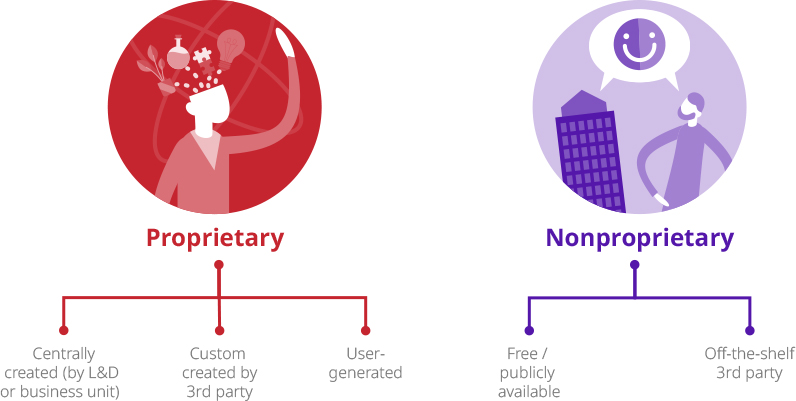Content in the 2020s: Enabling Learning
March 2nd, 2021
Why We Care
We’ve been thinking, talking, and writing about the employee learning experience—its many parts and layers—for a long time. With past research, we’ve emphasized how critical it is for L&D to empower the entire employee learning journey: plan, discover, consume, experiment, connect, and perform.1
Content’s always been a major part of this learning journey—and the time has come to gain a better understanding of how current content trends are affecting learners and orgs alike:
With so much content available in so many places—and many more learners now attempting to access content remotely—L&D must get a handle on how to enable employees to have the right learning experiences.
By “right learning experiences,” we mean enabling learners to access the right content, at the right time, in the right format for their needs and situation. One big challenge: the “right learning experience” changes from employee to employee and from situation to situation.
A Flood of Learning Content
We’ve been witnessing rapid growth in the amount, types, and sources of content available to learners.
Until recently, almost all learning content was proprietary—created by a central authority (or authorities) in an org for employees of that org. First, we saw a boom in nonproprietary, third-party off-the-shelf content: Designed primarily for leadership development, it burst into areas like frontline training, sales, customer service, and much more.
Until recently, almost all learning content was proprietary. That's changed rapidly. Now there's a sea of content—proprietary and nonproprietary—that learners sometimes struggle to navigate.
Then user-generated content (a subset of proprietary content, but unique in that it's much harder to regulate) became a viable way to scale content creation and support collaborative learning for many orgs.
In response, we saw an increase in market demand for and vendor supply of user-generated content solutions. Figure 1 illustrates content types as we see them today.

Figure 1: Current Understanding of Content Types | Source: RedThread Research, 2021.
Most recently, we’ve seen how L&D functions are struggling to account for (and tie to business goals) all the free, publicly available, uncontrolled content floating out there on the internet—that their learners are accessing and using.
As employees accessed more content in more ways, many L&D teams assumed (incorrectly) that more is better. They focused on giving learners access to all the content they could—proprietary and nonproprietary—including the proverbial kitchen sink. This strategy, they reasoned, would guarantee learners access to the content they needed!
Everything & the Kitchen Sink Just Doesn’t Work
In recent years, and especially with more employees working from home since COVID-19’s onset, the provide-everything content approach has shown its weaknesses—not the least of which is flooding learners with just too much.
- Cause: Employees are overwhelmed by the amount of content at their fingertips and struggle to navigate to what they really need.
- Effect: This situation discourages many employees from taking advantage of learning opportunities, ultimately hindering their performance and the org’s.
Providing tons of content also makes it difficult to ensure employees access the best (most relevant, highest quality) content or the content that most closely supports organizational priorities.
For example, let’s say the best content for a given employee and situation is a proprietary document created by a central L&D professional. But the easiest-to-access content is a public, nonproprietary video on YouTube. Which content is the employee more likely to consume? Probably the YouTube video—which isn’t ideal for the employee’s development or the org’s goals. This type of situation presents a challenge for L&D.
Learning depends not only on what the content is, but also on how it’s accessed.
There’s a growing recognition that learning depends not only on what the content is, but also on how it’s accessed. Successful learning means employees get the right content, yes—but they also get that content at the right time and in the right format / modality (in-person, virtual, mobile, coaching, on-the-job practice, etc.).
What We’ll Research
The challenge facing L&D has become:
How can orgs continually enable learners to access the right content, at the right time, in the right format—in short, to have the right (best) learning experience?
We want to understand this question in detail, with a focus on how the answers change based on content type—proprietary or nonproprietary. We sense that content type strongly influences what the "right content" is and how it should be delivered. In particular, we hope to understand:
- How orgs identify / select content that meets both critical org priorities and individual employee needs
- How orgs manage content to be delivered whenever / however it’s needed
- How orgs prioritize content so as not to overwhelm learners (i.e., identify the best content for a particular situation)
- How orgs tie all of these varied ways of learning to improvements in key business outcomes
- How these answers change based on content type (proprietary / nonproprietary)
How You Can Participate
Be an active part of our learning content research—here’s 3 ways:
- Join us for the roundtable. We’ll be hosting a roundtable on this topic—we’re looking for forward-thinking leaders to participate. The roundtable will be held on Tuesday, April 13 from 11am ET to 12:20pm ET. Apply to participate here.
- Let us interview you! Tell us what your org’s doing and how you're approaching content challenges. Reach out to us at [email protected].
- Join the conversation. Read our research and tell us what you think! Leave a note below or send us an email. Your comments make us smarter and the research better.
Heather Gilmartin Adams
Footnotes
- The Art and Science of Designing a Learning Tech Ecosystem, RedThread Research / Dani Johnson & Priyanka Mehrotra, 2020.